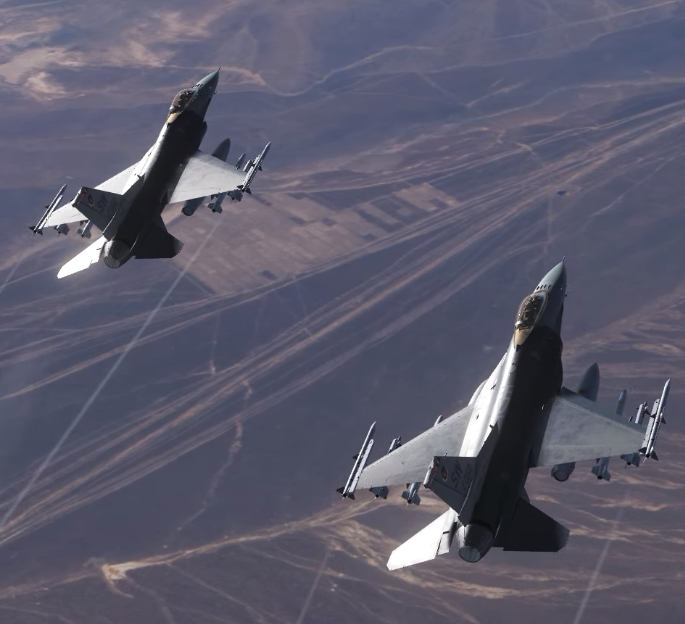Difference between revisions of "F-16C"
(→Digital Systems Overview) |
|||
| Line 1: | Line 1: | ||
| + | {{ModuleInfo | ||
| + | |modulename=F-16C | ||
| + | |modulethumb=F-16C Flying.png | ||
| + | |guidelink=http://wiki.hoggitworld.com/F-16C | ||
| + | |storelink=https://www.digitalcombatsimulator.com/en/shop/modules/viper/ | ||
| + | |trailerlink=https://www.youtube.com/watch?v=8QfANpD0GHY | ||
| + | }} | ||
| + | |||
The '''F-16C Fighting Falcon''', often called the '''Viper''', is a single-engine multi-role fighter jet airplane. The F-16 was created by General Dynamics (now Lockheed Martin) and operated by the United States Air Force and numerous other militaries. Despite the "F" (fighter) designation, it is designed for both air-to-air and air-to-ground missions and can use an array of weapons and sensors; built into the Viper is a 20mm cannon as well as a multifunction radar. The DCS F-16C models a Block 50 aircraft with the new F110-GE-129 engine and the Common Configuration Implementation Program (CCIP) avionics upgrade. | The '''F-16C Fighting Falcon''', often called the '''Viper''', is a single-engine multi-role fighter jet airplane. The F-16 was created by General Dynamics (now Lockheed Martin) and operated by the United States Air Force and numerous other militaries. Despite the "F" (fighter) designation, it is designed for both air-to-air and air-to-ground missions and can use an array of weapons and sensors; built into the Viper is a 20mm cannon as well as a multifunction radar. The DCS F-16C models a Block 50 aircraft with the new F110-GE-129 engine and the Common Configuration Implementation Program (CCIP) avionics upgrade. | ||
Revision as of 09:55, 1 October 2019
The F-16C Fighting Falcon, often called the Viper, is a single-engine multi-role fighter jet airplane. The F-16 was created by General Dynamics (now Lockheed Martin) and operated by the United States Air Force and numerous other militaries. Despite the "F" (fighter) designation, it is designed for both air-to-air and air-to-ground missions and can use an array of weapons and sensors; built into the Viper is a 20mm cannon as well as a multifunction radar. The DCS F-16C models a Block 50 aircraft with the new F110-GE-129 engine and the Common Configuration Implementation Program (CCIP) avionics upgrade.
HOTAS
The Fighting Falcon's hands on throttle and stick (HOTAS) system is designed to allow the pilot to manipulate important avionics functions without releasing the hands from the throttle or control stick.
Digital Systems Overview
The F-16's avionics are interfaced with via two Multifunction Displays (MFDs), the Integrated Control Panel (ICP), the Data Entry Display (DED), and the head-up display (HUD)/helmet mounted curing system (HMCS). The hands on throttle and stick (HOTAS) system of the aircraft is also used for manipulating these systems, which is detailed in its own section and the sections relevant to specific HOTAS uses.
Sensor of Interest
In the F-16, either the HUD/HMCS, the left MFD, or the right MFD is the designated Sensor of Interest, or "SOI." The SOI is used to dictate what HOTAS buttons do what function. The SOI is changed via the Display Management Switch (DMS) on the stick - UP will assign SOI to the HUD/HMCS while DOWN will cycle SOI between the left and right MFDs. If an MFD is SOI, a white border around it is displayed. If the HUD is SOI, an asterisk is put in the upper left corner.
Multifunction Displays
The F-16 has two Multifunction Displays (MFDs) on the left and right sides of the cockpit: each has 5 option select buttons (OSBs) on all four sides. The MFDs can display various software pages to manipulate the aircraft's avionics. Up to three pages per MFD can be selected on either MFD for quick access via pushbutton or HOTAS. These three pages always occupy the bottom center three pushbutton areas. In addition to these, a universal declutter (DCLT) button is provided, which will declutter the symbology depending on the page, and a SWAP button, which simply swaps the two MFD's quick access pages and selected page.
Selecting any of the three pushbuttons once they have already been selected prompts the main page menu. Any page can then be selected and will be filled at that pushbutton. That page can then be selected by either pressing the corresponding pushbutton or using the Display Management Switch (DMS) on the stick, and it will be highlighted. TMS LEFT and RIGHT respectively cycle the three quick access pages on the left/right MFDs in an outward fashion.

